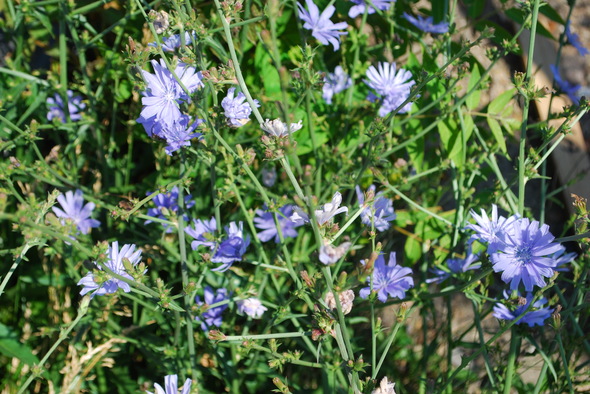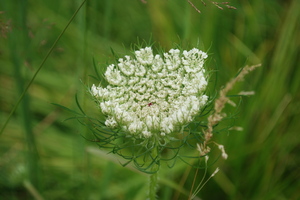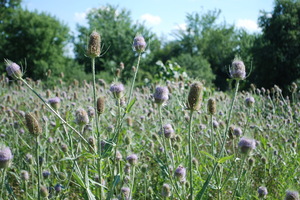Roadside plants are pretty, but many aren't native to Michigan

A mass of Chicory (Cichorium intybus) adds alien color to a roadside near you.
Rick Meader | Contributor
Last fall we took a drive along some country roads and found some beautiful native asters blooming their hearts out, to our delight.
Right about now, if you take a drive along those same roads, you may find pretty lavender, white and yellow flowers blooming their hearts out, but there is a good chance they’re not native wildflowers.
Chicory, Queen Anne’s Lace and Teasel are all in bloom right now and are common along roadsides, but all have been introduced intentionally or accidentally from Europe, thanks to European settlers.
They may be flowers growing in the wild, but they’re not native to Michigan or even North America. I think it’s important that you know what is native and what isn’t, even if it’s pretty, so you don’t accidentally include it in a native butterfly garden or prairie/meadow planting and crowd out true natives.
So, without further ado, let’s learn more about these pretty but “not-from-around-here" wildflowers.
The first flower that you’re bound to see blooming along sunny country roads right about now is Chicory (Cichorium intybus), a plant introduced from Europe. (Don’t ask me to pronounce that scientific name.)
Chicory is a plant with light blue composite flowers about one to one and a half inches wide that arise from the stalk. It likes sunny waste places, such as roadsides or even lawns, and grows to between one to four feet tall (unless it’s mowed down).
One fun fact about it is that each flower blooms one day, to be replaced by another the next. Some people use chicory root as a coffee substitute. Find some good additional information about it here.

Queen Anne's Lace (Daucos carota) spreads its flowers over a vacant field.
Rick Meader | Contributor
Queen Anne’s Lace, or Wild Carrot (Daucus carota) is as widespread as wildflowers get. Originally introduced from Europe, you’ll find it in fields, yards, roadsides and parking lots.
Its white flower is an umbel that can get as much as four feet wide and may have a single purple floret in the center (look for it; I didn’t know it was there for years). When it dries, the flower closes up into a “bird's nest” that holds sticky seeds that will surely get stuck to your clothes if you brush against it. It grows to about one to three feet tall and may dominate an old field.
Here is some detailed information about it with some good photos.
Teasel (Dipsacus sylvestris) is an interesting-looking wildflower commonly found along highways and in fields near them. It seems to me that they are becoming more widespread in recent years, but that could be a case of me noticing them more. It is a favorite of dried flower arrangers as the flower/seedhead is a cone-shaped structure that is surprisingly prickly, with long leaf-like appendages at the base that are persistent when they dry.
If you look closely at a blooming teasel, you’ll see that it has light lavender florets that bloom their way up the cone. The plant was introduced from Europe in the 1700s and can reach six feet tall. The Wisconsin DNR website has some good information about it.

Teasel (Dipsacus sylvestris) takes over a roadside that used to have native plants.
Rick Meader | Contributor
If you look closely at the species list of “wildflower” seed mixes available for sale in common retailers and even some mainstream nurseries, you’ll find that they often contain a laundry list of species, many of which are not native to Michigan. I highly recommend that you stay away from them.
You may be introducing weeds you can’t easily get rid of and that could spread to your neighbor’s yard or into natural areas in your vicinity. You can get mixes of native Michigan plants from Michigan native seed suppliers such as Michigan Wildflower Farm in Portland, Mich., that are sure to be free of alien invasives.
In addition to Michigan Wildflower Farm, you can find other seed suppliers and plant suppliers on the Michigan Native Plant Producers Association website. When it comes to wildflowers, do your best to stay native.
The heat is drying out even my little prairie-let, but blooming in my yard this week are: Woodland tick trefoil, Showy tick trefoil, Bugbane, Agrimony, Black-eyed Susan, White Snakeroot, Culver’s Root, Wild bergamot, Grey-headed coneflower, Woodland sunflower, Big bluestem, Yarrow, Swamp milkweed and False Sunflower.
Get out and enjoy nature, everyone!
Rick is a local landscape architect with a special interest in all things natural, including native plants and the critters that eat them. You can contact him at yourland1824@gmail.com.


Comments
Rick Meader
Fri, Jul 29, 2011 : 10:59 p.m.
Thanks, Rork. Good job on spreading the beetle. I have noticed that the wetland along Huron River Drive, just west of Hogback, has a lot less blooming loosestrife than it had in the past. If that was your work, great job! I don't know what's going on with the Queen Anne's Lace spiders. Does anyone else? Rick
Rork Kuick
Thu, Jul 28, 2011 : 3:59 p.m.
In wet stuff, the purple loosestrife is also pretty now. I still occasionally see it in people's flower beds! Join in the fight and kill it where you see it. In my volunteer work we collect the beetle that eats it from places where there are many, and move it to places in loosestrife overwhelm - it doesn't eradicate the plant (so far), but does knock it down. An interesting thing I've seen about Queen Anne's Lace on occasion are small white spiders on the flowers. I don't know what they are, but figure they are ambushing insects visiting the flowers. When doing web search for it, I do see pictures of "white crab spiders", but not sure that is the one I've seen. Hope the very heavy rains of last night were a blessing rather than a disaster for Rick, and others, including our local farmers.